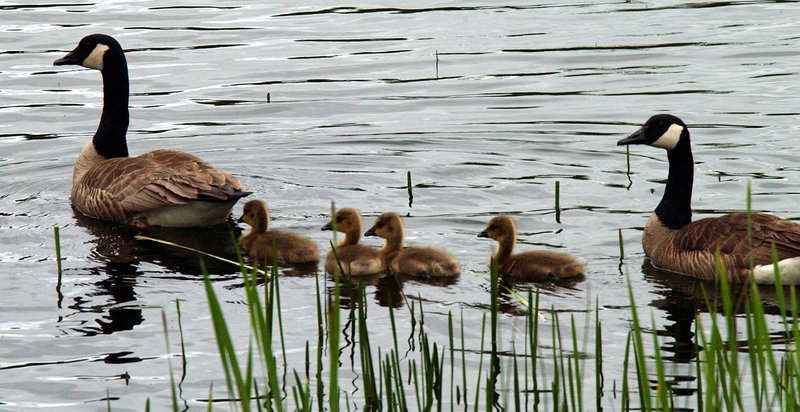In today’s column, I will review some recently published findings by scientists involving birds that occur in Maine, although the research was done elsewhere.
Canada geese females usually lay between seven and nine eggs. The young all hatch at the same time, even though females can only lay one egg a day. One might think that the female would not start to incubate the eggs until the last one is laid so the eggs would develop at the same rate. Yet, females start to incubate at day three. How can those eggs laid later possibly catch up?
The mystery was solved by Mark Clark and colleagues, as described in a Condor article. They showed that the female adjusts the structure of the egg shell depending on when in the sequence an egg is laid.
Eggs laid later had shells that were more porous and better conductors of heat than shells of early eggs. The later eggs absorb more heat from the incubating mother and grow more rapidly than the chicks in early eggs. The result is that all chicks end up ready to hatch together.
Birders know that municipal dumps and landfills are great places to look for gulls. A large mound of garbage can attract hundreds of herring gulls, ring-billed gulls and great-black backed gulls. Often a few Iceland gulls and glaucous gulls can be present outside of their nesting seasons.
Despite the attraction of gulls for garbage, surprisingly little work has been done to determine if this supplemental food improves gull survival and reproduction.
A recent paper in Condor by Emily Weiser and Abby Powell examined the importance of garbage on the survival and nesting success of glaucous gulls in Alaska. Their results should be applicable to Maine.
They studied 10 glaucous gull colonies in Alaska.
Some colonies were within 3 miles of a landfill, others as far as 45 miles away.
Garbage could be detected in the pellets of 85 percent of the gulls close to landfills.
Weiser and Powell found a very strong effect of garbage on nesting success.
Gulls who got most of their food from garbage fledged more young. Although garbage likely allows gull populations to grow, the presence of garbage may benefit the shorebirds and waterfowl that glaucous gulls normally feed on by reducing their predation risk.
The saltmarsh sparrow reaches its northern nesting limit in southern Maine. This species is unusual compared to most songbirds because individuals do not form pair bonds and they are not territorial.
The female provides all the parental care to the offspring.
Some observations suggest that saltmarsh sparrow nests tend to occur in clusters or “hot spots.” Some workers claimed that these clusters are associated with particular characteristics of the marsh that provide the best nesting microhabitat.
In a recent Auk article, Trina Bayard and Chris Elphick studied two populations of saltmarsh sparrows in two Connecticut marshes adjacent to Long Island Sound. Their goal was to rigorously test the claim that saltmarsh sparrow nests are clustered.
They sought to find evidence that vegetation differences across the marshes and the presence of other saltmarsh sparrow nests might influence nest site selection.
They found 213 nests and documented the characteristics of the vegetation around each nest. They found that neither the proximity of other nests or vegetation characteristics influenced nest site selection.
In other words, the nests occur randomly in the two marshes. A careful study put paid to the claim that saltmarsh sparrows nest together.
Bicknell’s thrushes nest in dense fir and red spruce habitat just below tree line in northern New England, the Adirondacks, Quebec and the Maritime Provinces.
The species winters in the Greater Antilles, primarily on Hispaniola. Because of the low population size and restricted areas for both nesting and wintering, Bicknell’s thrushes rank high on species of concern lists.
Little was known about the wintering behavior of this species until a recent Auk article by Jason Townsend and colleagues provided important new information. These authors studied two populations of wintering Bicknell’s thrushes in the Dominican Republic, one at a mid-elevation rainforest site and one at a high-elevation cloud-forest site.
The birds at the lower site primarily fed on fruits while the cloud-forest birds fed mostly on insects and other arthropods.
In both cases, the birds maintained solitary territories; a male or a female defended its territory from all comers. The results suggest that both fruits and arthropods are resources that are worth defending for wintering thrushes.
Herb Wilson teaches ornithology and other biology courses at Colby College. He welcomes reader comments and questions at:
whwilson@colby.edu
Copy the Story Link
Send questions/comments to the editors.



Success. Please wait for the page to reload. If the page does not reload within 5 seconds, please refresh the page.
Enter your email and password to access comments.
Hi, to comment on stories you must . This profile is in addition to your subscription and website login.
Already have a commenting profile? .
Invalid username/password.
Please check your email to confirm and complete your registration.
Only subscribers are eligible to post comments. Please subscribe or login first for digital access. Here’s why.
Use the form below to reset your password. When you've submitted your account email, we will send an email with a reset code.